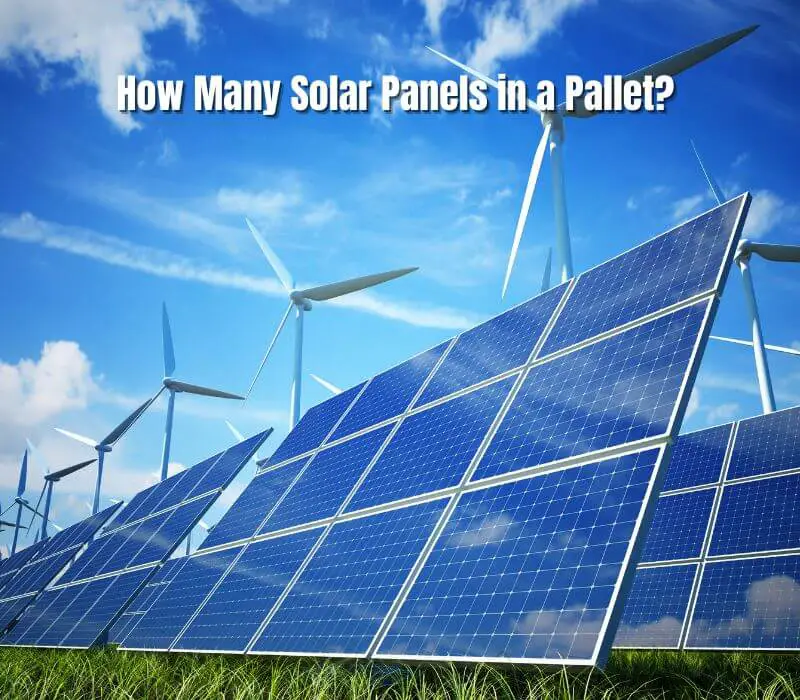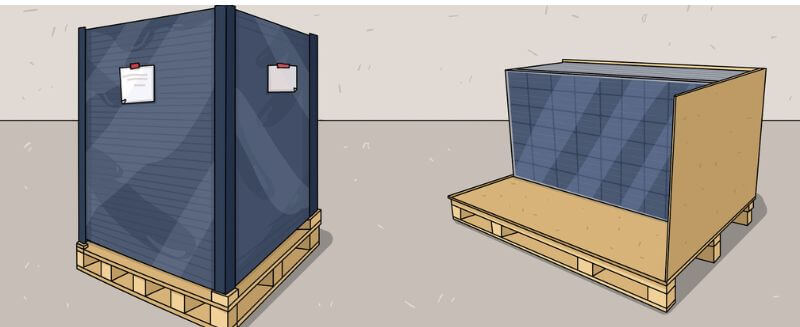How are Solar Modules Shipped? (Here is the Reply)
Solar modules are shipped in containers and others that helps to protect them from the elements and keep them secure during transit. The average container can hold around 50 solar modules, although this will vary depending on the size and type of module being shipped. Solar modules are typically wrapped in a protective material such as bubble wrap or foam before being placed in the container.
Once all of the modules have been loaded into the container, it is then sealed and ready for transport.
Solar modules are shipped in a variety of ways, depending on the size and type of module. The most common method is to use a pallet or crate. Solar modules can also be shipped on rollers or in special containers. Sometimes solar panels can fail due to improper use.
Solar Panel Packaging Material
If you’re looking to go solar, one of the first decisions you’ll need to make is what type of solar panel packaging material you want. There are a few different options on the market, each with its own set of pros and cons. In this blog post, we’ll break down the most popular types of solar panel raw materials & packaging materials so that you can make an informed decision for your home or business.
The most common type of solar panel packaging material is glass. Glass is a great option because it’s durable and has a high transparency rating, which means that more sunlight will reach the cells inside the panel. However, glass can be heavy and difficult to transport, and it’s also one of the more expensive options.
Another popular option is plastic. Plastic is much lighter than glass, making it easier to transport and install. It also has a lower transparency rating, which means that less sunlight will reach the cells inside the panel.
However, plastic is not as durable as glass and may yellow over time from exposure to UV rays. The last type of solar panel packaging material we’ll discuss is metal. Metal panels are very strong and durable, but they’re also very heavy and difficult to transport.
They also have a low transparency rating, which means that less sunlight will reach the cells inside the panel. However, metal panels are usually less expensive than glass or plastic panels.
Solar Panels International Shipping
If you’re considering solar panels for your home or business, you may be wondering if it’s possible to have them shipped internationally. The good news is that solar panels can be shipped just about anywhere in the world. However, there are a few things to keep in mind when shipping solar panels internationally.
| First, it’s important to choose a reputable and experienced shipping company | This will ensure that your panels are properly packaged and protected during transit. It’s also a good idea to get a quote from multiple shipping companies so you can compare costs. |
| Second, you’ll need to make sure that the country you’re shipping to has the proper infrastructure in place to support solar panel installation | This includes having trained professionals who can install the panels correctly. Otherwise, you may end up with subpar results or even damage to your property. |
| Finally, it’s important to factor in customs fees and other charges when calculating the cost of shipping solar panels internationally | These fees can vary widely depending on the country you’re shipping to, so be sure to do your research beforehand. |
| Overall, shipping solar panels internationally is definitely possible | But it’s important to take all of these factors into consideration before making your final decision. |
How Many Solar Panels in a 40ft Container?
Are you looking for a cost-effective way to ship solar panels? If so, you may be wondering how many solar panels fit in a 40-foot container.
A 40-foot container can hold up to 300 solar panels.
This number will vary depending on the size and type of panel that you are shipping. For example, if you are shipping thin film panels, you will be able to fit more panels in the container than if you are shipping crystalline silicon panels.
If you are looking for a cost-effective way to ship your solar panel products, consider using a 40-foot container.
You will be able to fit a large number of panels in the container and save on shipping costs.
Companies That Ship Solar Panels
There are many companies that ship solar panels, but only a few that specialize in them. The top three companies that come to mind are Solar World, Suniva, and Sharp. All three of these manufacturers have their own unique processes for making and shipping solar panels.
Solar World is the largest solar panel manufacturer in the United States. They have been in business since 1975 and have over 1,000 employees. Solar World has its headquarters in Hillsboro, Oregon, and also has manufacturing facilities in Arizona and California.
The company offers both residential and commercial solar panel solutions. Suniva is another large solar panel manufacturer based out of Georgia. The company was founded in 2007 by two engineers who wanted to make high-quality solar cells more affordable.
Suniva has over 250 employees and sells its products worldwide. Sharp is a Japanese electronics company that also manufactures solar panels. Sharp has been in business since 1912 and employs over 50,000 people worldwide.
Solar Panel Shipping Cost
The average cost to ship a solar panel is about $0.50 per mile. So, if you are shipping a solar panel from Los Angeles to New York, the cost would be about $2,500. The cost of shipping a solar panel from California to Florida would be about $1,000.
How Many Solar Panels in a Pallet?

A pallet of solar panels usually contains 36 panels, but the number can vary depending on the size and type of panel. Solar panels are typically around 40 inches by 60 inches, so a pallet would be able to hold 9 panels in total. The average solar panel produces around 200 watts of power, so a pallet of solar panels could generate around 7,200 watts of power.
Handling Solar Panels
Solar panels are a great way to save on your energy bill, but they can be a bit of a hassle to deal with. Here are some tips for handling solar panels:
| Make sure that you have the proper equipment | Solar panels can be delicate, so you’ll need to make sure that you have the right tools for the job. At a minimum, you’ll need gloves, a screwdriver, and something to clean the panels with (a soft cloth or brush) |
| Be careful when cleaning them | When you’re cleaning the solar panels, be careful not to scratch or damage them. Use a soft cloth or brush, and avoid using any harsh chemicals. |
| Don’t forget about maintenance | Solar panels require very little maintenance, but it’s still important to check on them from time to time. Once a year, you should clean the panel’s surface and check all of the connections to make sure everything is tight and secure. |

People Also Asked
How Do You Ship Solar Panels?
Assuming you are talking about photovoltaic solar panels, here is how they are shipped.
Solar panels are made of glass and metal, which makes them vulnerable to breakage during shipping. That’s why it’s important that they be properly packaged to ensure their safety during transit.
The first step is to secure the solar panel to a pallet using straps or other means. This will help to prevent the panel from shifting during shipping and potentially breaking.
Once the panel is secured, it can be wrapped in bubble wrap or another type of padding material.
This will further help to protect it from bumps and jostling during shipping.
After the panel is wrapped, it can be placed in a box or crate for shipment. When choosing a container, make sure that it’s sturdy enough to withstand rough handling.
It’s also important to choose a size that’s appropriate for the solar panel so that it doesn’t shift around inside and become damaged.
How Long Does It Take to Ship Solar Panels?
It usually takes about a week to ship solar panels from the time of ordering. The process begins with the manufacturing of the panels, which generally takes a few days. Once the panels are ready, they are shipped to the customer via truck or rail.
How Can Solar Energy Be Delivered?
Solar energy is a renewable resource that can be used to generate electricity or heat. Solar panels convert sunlight into electrical energy, which can then be used to power homes and businesses or to heat water for domestic use. Solar thermal systems use the sun’s energy to heat water or air, which can then be used for space heating, domestic hot water, or industrial process heat.
Solar PV and solar thermal technology are both well-established and there are a number of ways in which they can be delivered. Solar PV panels can be installed on rooftops or integrated into the fabric of buildings. They can also be mounted on poles or tracking systems in open ground-mounted arrays.
Large-scale solar farms are another option for delivering solar PV, with projects now underway in many countries around the world. Solar thermal collectors are usually mounted on rooftops, but can also be ground-mounted, wall-mounted, or integrated into building designs. Solar PV cells generating electricity directly from sunlight are also known as photovoltaics (PV).
The main types of solar PV cells are crystalline silicon, cadmium telluride, and copper indium gallium selenide/sulphide. These cells are assembled into modules (sometimes called ‘panels’ or ‘arrays’) containing up to several hundred cells connected together electrically in series by wiring between the positive (+) terminal of one cell and the negative (-) terminal of the next cell along.
Are Solar Panels Easy to Transport?
Are solar panels easy to transport? The answer is yes, they are. Solar panels are made of lightweight materials like plastic and glass, so they’re easy to carry and move around.
You can even fold them up for storage or transportation.
If you want to know what type of wire is used to connect solar panels? Read this article.
Final Verdict
Solar modules are shipped in a variety of ways, depending on the size and type of module. The most common type of solar module is photovoltaic (PV) module, which is used to generate electricity from sunlight. PV modules are typically shipped in containers that can hold up to 30 modules.
Large PV modules may be shipped on flatbed trucks or in railroad cars.
Learn More:
